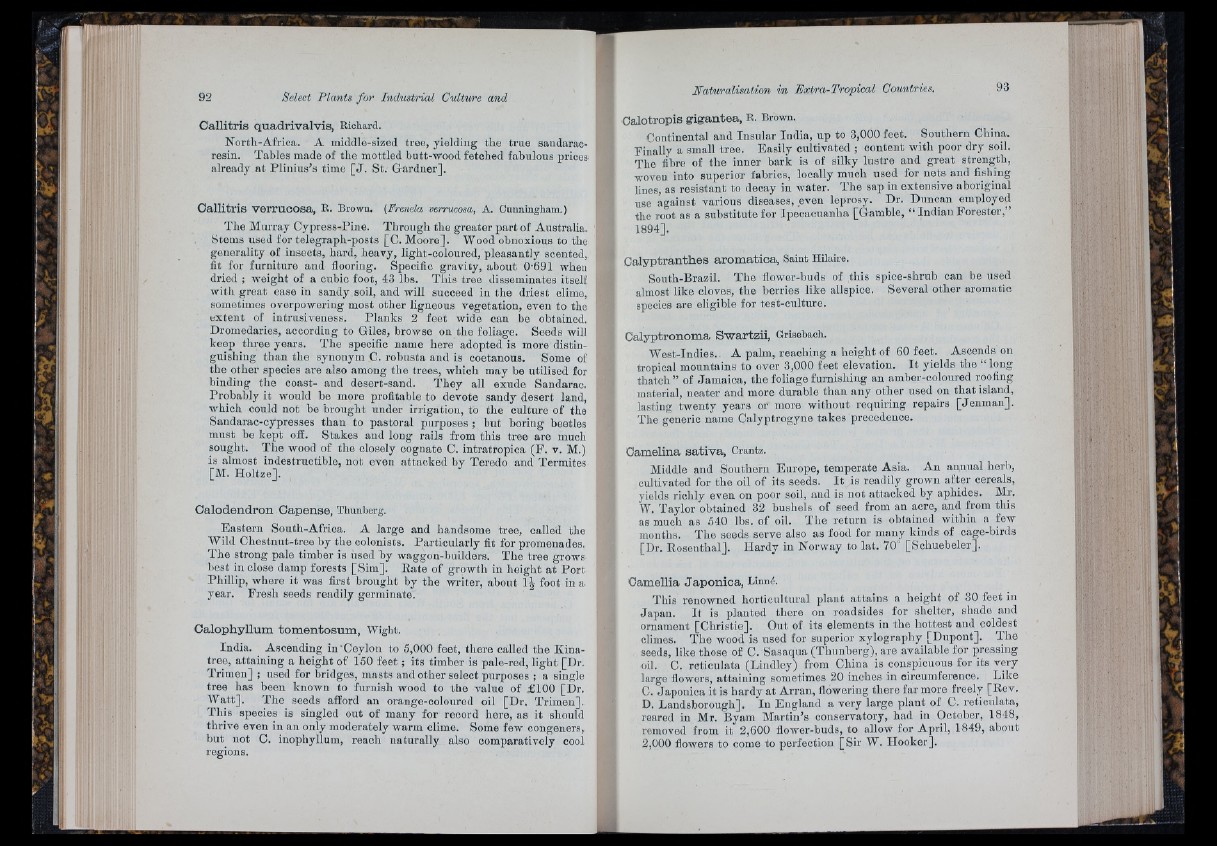
Select Plants fo r Industrial Culture and
C a ll i tr i s q u a d r iv a lv i s , Richard.
North-Africa. A middle-sized tree, yielding the true sandarao-
resin. Tables made of the mottled butt-wood fetched fabulous prices
already a t Plinius’s time [ J . St. Gardner].
C a ll i tr i s v e r r u c o s a , R. Brown. (Frenela verrucosa, A. Cunningham.)
The Murray Cypress-Pine. Through the greater part of Australia.
Stems used for telegraph-posts [C. Moore]. Wood obnoxious to the
generality of insects, hard, lieavy, light-coloured, pleasantly scented,
fit for furniture and flooring. Specific gravity, about 0-691 when
dried ; weight of a cubic foot, 43 lbs. Tliis tree disseminates itself
witli great ease in sandy soil, and will succeed in the driest clime,
sometimes overpowering most other ligneous vegetation, even to the
extent of intrusiveness. Planks 2 feet wide can be obtained.
Dromedaries, according to Giles, browse on the foliage. Seeds will
keep three years. The specific name here adopted is more distinguishing
than the synonym C. robnsta and is coetanous. Some of
the other species are also among the trees, which may be utilised for
binding the coast- aud desort-sand. They all exude Sandarac.
Probably it would be more profitable to devote sandy desert land,
which could not be brought under irrigation, to the culture of the
Sandarac-cypresses than to pastoral purposes ; but boring beetles
must bo kept off. Stakes and long rails from this tree are much
sought. The wood of the closely cognate C. intratropica (F. v. M.)
is almost indestructible, not even attacked by Teredo and Termites
[M. Holtze],
C a lo d e n d r o n C a p e n s e , Thunberg.
Eastern South-Africa. A large and liandsome tree, called the
Wild Chestnut-troo by the colonists. Particularly fit for promenades.
year. Fresh seeds readily germinate.
C a lo p h y llu in t o m e n to s u m , Wight.
India. Ascending in ‘Ceylon to 5,000 feet, there called the Kina-
tree, attaining a height of 150 feet ; its timber is pale-red, light [Dr.
Trimen] ; used for bridges, masts and otlier select purposes ; a single
tree has been known to furnish wood to the value of £100 [Dr.
Watt]. Tlie seeds afford an orange-coloured oil [Dr. TTimen].
This species is singled out of many for record here, as it should
thrive even in an only moderately warm clime. Some few congeners,
but not C. inopliyllum, reach naturally also comparatively cool
regions.
C a lo tro p is g ig a n t e a , R. Brown.
Continental and Insular India, up to 3,000 feet. Southern China.
Finally a small tree. Easily cultivated ; content with poor dry soil.
The fibre of the inner bark is of silky lustre and great strength,
woven into superior fabrics, locally much used for nets and fishing
lines, as resistant to decay in water. The sap in extensive aboriginal
use against various diseases, even leprosy. Dr. Duncan employed
the root as a substitute for Ipecacuanha [Gamble, “ Indian Forester,”
1894].
C a ly p t r a n th e s a r o m a t i c a , Saint Hilaire.
South-Brazil. The flower-buds of this spice-shrul) can be used
almost like cloves, the berries like allspice. Several other aromatic
species are eligible for test-cnlture.
C a ly p tro n om a S w a r tz ii, Grisebach.
West-Indies., A palm, reaching a height of 60 feet. Ascends on
tropical mountains to over 3,000 feet elevation. I t yields the “ long
th a tch ” of Jamaica, the foliage furnishing an amber-coloured roofing
material, neater and more durable than any other used on tliat island,
lasting twenty years or more without requiring repairs [Jenman].
The generic name Calyptrogyne takes precedence.
C am e lin a s a t iv a , Crantz.
Middle and Southern Europe, temperate Asia. An annual herb,
cultivated for the oil of its seeds. I t is readily grown after cereals,
yields riclily even on poor soil, and is not attacked by aphides. Mr.
W. Taylor obtained 32 bushels of seed from an acre, and from this
as much as 540 lbs. of oil. The return is obtained witliin a few
months. Tlie seeds serve also as food for many kinds of cage-birds
[Dr. Rosenthal]. Hardy in Norway to lat. 70° [Schuebeler].
C am e llia J a p ó n i c a , Linné.
This renowned iiorticultural plant attains a height of 30 feet in
Japan. It is planted there on roadsides for shelter, shade and
ornament [Christie]. Out of its elements in the hottest and coldest
climes. The wood is used for superior xylography [Dupont]. The
seeds, like those of C. Sasaqua (Thunberg), are available for pressing
oil. C. reticulata (Lindley) from China is coiispicnons for its very
large flowers, attaining sometimes 20 inches in circumference. Like
C. Japónica it is hardy at Arran, flowering there far more freely [Rev.
D. Landsborough]. In England a very largo plant of C. reticulata,
reared in Mr. Byam Martin’s conservatory, had in October, 1848,
removed from it 2,600 flower-huds, to allow for April, 1849, about
2,000 flowers to come to perfection [S ir W. Hooker].
r; ■ • -fr'‘ '
Isii;